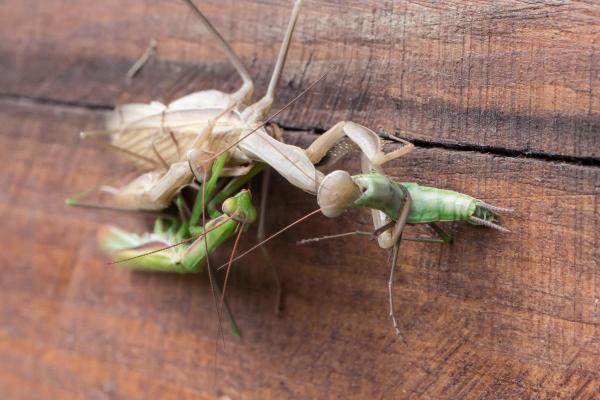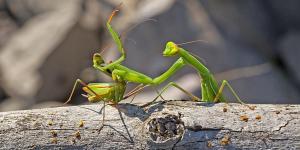Why Do Praying Mantis Eat Their Mate?


There are many surprising and often baffling behaviors in the animal kingdom, but one of the most notorious is the sexual cannibalism of the praying mantis. The image of a female praying mantis devouring her mate after or even during breeding is hard to ignore. But why does this seemingly self-destructive behavior occur? The practice is actually common among mantises, and has a number of benefits for their survival and reproduction.
In this article, we will explore the fascinating world of sexual cannibalism in praying mantises and the benefits that this behavior can have for the survival and reproductive success of these creatures.
Do praying mantis eat the males?
The popular belief that all praying mantises eat their male partners after or during mating is a myth. While sexual cannibalism does occur in some praying mantis species, it is not universal and is only observed in a relatively low percentage of cases.
In fact, sexual cannibalism is most commonly observed in captive praying mantises, where stress and lack of access to other food sources can increase the likelihood of a female devouring the male. In the wild, where praying mantises have access to a variety of prey, sexual cannibalism is less likely to occur.
However, it is important to note that sexual cannibalism is not essential for praying mantis reproduction. In fact, many praying mantis species reproduce successfully without the female eating the male.
It is important to note that sexual cannibalism is not a harmful or unethical behavior in the context of praying mantis natural history. It is simply a strategy that some females employ to maximize their reproductive success. Finally, it is worth mentioning that sexual cannibalism is also seen in other species like black widow spiders, scorpions, grasshoppers, and beetles.
Can male mantis eat female mantis?
Yes, male mantises can eat female mantises, although it is less common than female mantises eating males. Sexual cannibalism, where one mantis consumes the other during or after mating, is more frequently observed with females consuming males. However, in some cases, particularly when resources are scarce or environmental conditions are unfavorable, male mantises may resort to cannibalism and consume the female before, during, or after mating. This behavior can occur but is generally less common compared to the reverse scenario.
Now that you know why praying mantis females eat their mates, learn more about insect brains and how they work in this article.

Why does the praying mantis eat the male?
Sexual cannibalism in praying mantises, where the female consumes the male after or during mating, is a captivating yet intricate behavior. Several factors contribute to this phenomenon, shedding light on the complex nature of this behavior.
Firstly, female mantises are inherently aggressive and predatory creatures. Consequently, they might occasionally misidentify a potential mate as prey due to their hunting instincts.
Furthermore, the act of consuming the male can provide the female with essential nutrients necessary for producing healthy eggs, thereby enhancing her reproductive success. Expectant mothers need lots of food to sustain their children, and the males offered a nearby source of protein.
Some females may be more inclined to cannibalize smaller or weaker males, as they offer a nutritious food source for the female, aiding in her reproductive efforts.
Eating the male after mating can also ensure that all of the female's eggs are fertilized by that specific male. This can be advantageous when mates are scarce or during the later stages of the breeding season.
In certain mantis species, males may actually mate more effectively when decapitated. This is because a nerve center in their heads inhibits mating until the female is securely clasped. Removing this inhibition allows for repeated copulation.
Additionally, stress or specific environmental conditions, such as captivity, can trigger cannibalistic behavior in mantises.
Praying mantis sexual cannibalism remains a subject of ongoing scientific investigation, but it is evident that it occurs commonly in some species and offers several potential benefits for the female's reproductive success.

How does the praying mantis eat the male?
In cases of sexual cannibalism in praying mantises, the female typically begins by seizing the male with her powerful front legs, immobilizing him. Then, she may bite off his head or part of his head. This act of decapitation is what many people associate with sexual cannibalism in mantises.
The decapitated male continues to function and may even complete the mating process, as copulatory movements in mantises are controlled by nerve tissue located in the abdomen rather than the head. This means that the male can still transfer sperm to the female after being decapitated.
The exact sequence of events can vary depending on the mantis species and the circumstances. Some females may begin consuming the male immediately, while others may wait until after mating is complete. The male's body provides a source of nutrition for the female, which can be beneficial for her reproductive efforts.
It's important to reiterate that not all mantis species engage in sexual cannibalism, and this behavior occurs in a minority of cases.
After learning about praying mantis cannibalism, you might be wondering which other animals are known for their aggression. Find out in this article.
Examples of praying mantises that eat the male
There are approximately 2,500 species of praying mantises (Mantodea) known to science, and researchers continue to discover new species as they explore various regions around the world.
These species vary in size, coloration, and behavior, and they are found in diverse habitats on nearly every continent. Examples of praying mantis species that are known for sexual cannibalism include:
- European praying mantis (Mantis religiosa)
- Nectar-eating mantis (Miomantis caffra)
- Giant black mantis (Hierodula gallinacea)
- Giant Asian mantis (Hierodula grandis)
- Chinese mantis (Tenodera aridifolia sinensis)
- Carolina mantis (Stagmomantis carolina)
- Giant African mantis (Sphodromantis lineola)
It's important to emphasize that not all individuals of these species engage in sexual cannibalism, and the occurrence of this behavior can vary depending on environmental conditions, stress, and other factors.
Wondering if praying mantises are poisonous? Find out in this article.

If you want to read similar articles to Why Do Praying Mantis Eat Their Mate?, we recommend you visit our Facts about the animal kingdom category.
- Birkhead, T. R., Lee, K. E., & Young, P. (1988). Sexual cannibalism in the praying mantis Hierodula gallinacea . Behavior, 112-118.
- Brown, W.D., Muntz, G.A., & Ladowski, A.J. (2012). Low mate encounter rate increases male risk taking in a sexually cannibalistic praying mantis . PLoS One, 7(4), e35377.
- Kynaston, S.E., McErlain-Ward, P., & Mills, P.J. (1994). Courtship, mating behavior and sexual cannibalism in the praying mantis, Sphodromantis lineola . Animal Behavior.
- Lelito, J.P., & Brown, W.D. (2008). Mate attraction by females in a sexually cannibalistic praying mantis . Behavioral Ecology and Sociobiology, 63, 313-320.
- Prokop, P., & Václav, R. (2008). Seasonal aspects of sexual cannibalism in the praying mantis . Journal of ethology, 26, 213-218.








